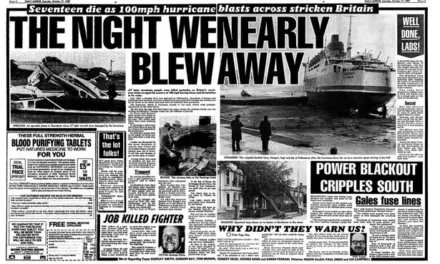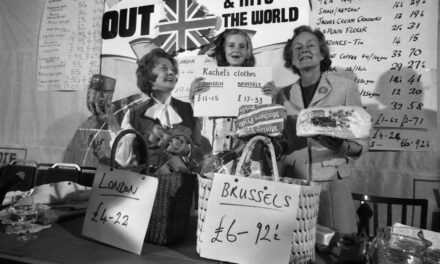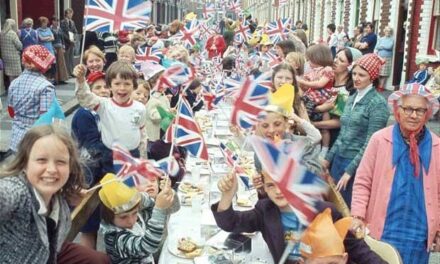1978 was a year of upheaval and unrest in Britain, with a sputtering economy and simmering social divisions coming to the fore. Yet it also produced significant cultural highlights across music, film, literature and sport.
As James Callaghan’s Labour government struggled to maintain control, the economy was plagued by rampant inflation, public sector strikes and shortages. The Winter of Discontent saw widespread industrial action that would help pave the way for Margaret Thatcher’s ascension.
Punk rock continued making an impact, with bands like The Clash and Buzzcocks cementing their legacies. Kate Bush’s ‘Wuthering Heights’ launched her career, blending literary romance with an otherworldly style. The country music-inspired ‘Stars on 45 Medley’ novelty single also topped charts.
Iconic films Superman and Grease premiered, the latter sparking a revival of 1950s pop culture. Agatha Christie’s final Poirot novel, Hallowe’en Party, hit bookshelves while young British writers like Martin Amis and Ian McEwan emerged.
On TV, the groundbreaking documentary series Life on Earth captivated viewers with David Attenborough’s first collaboration with the BBC Natural History Unit. Sitcom Fawlty Towers and magazine show Not The Nine O’Clock News also debuted to acclaim.
In football, Ipswich Town improbably won the FA Cup while Liverpool retained the First Division title. The Dallas Cowboys topped the Pittsburgh Steelers in Super Bowl XIII, while New York regained the US Open men’s tennis crown.
The devolution referendums saw Scotland and Wales vote for greater autonomy, although the Welsh poll fell short of the required threshold. In Northern Ireland, the IRA committed several attacks, including the La Mon restaurant bombing which killed 12 people.
1978 proved a flashpoint for simmering divides as economic malaise and political uncertainty took hold. Yet Britain’s vibrant popular culture thrived amid the tumult, underscoring the country’s contrasts and tensions during this testing yet energising time.

Music
The Bee Gees Dominate Charts
The Bee Gees cemented themselves as the preeminent pop act in the world, thanks largely to their chart-topping contributions to the Saturday Night Fever soundtrack. For much of the year, the Australian Gibb brothers maintained an unparalleled level of musical dominance across radio airwaves, global sales charts, and pop culture consciousness.
Saturday Night Fever was released in November 1977 as the soundtrack to the hit film starring John Travolta. Laden with Bee Gees compositions in their distinctive high-pitched style, the album gained momentum through the first half of 1978 before shooting to unprecedented commercial heights. Powered by funky dance grooves and lush ballads, Saturday Night Fever would become the highest selling album in history to that point.
The Bee Gees themselves monopolised the top of music charts with six consecutive #1 Billboard Hot 100 hits, all culled from the Saturday Night Fever album. Smashes like “Stayin’ Alive,” “Night Fever,” and “How Deep is Your Love” provided the soundtrack for a disco frenzy that had swept dance floors and airwaves internationally. The band’s unique falsetto vocals and tight harmonies perfectly captured the era’s dance floor euphoria.
Incredibly, at one point in early 1978, the Bee Gees held down the #1 and #2 chart positions simultaneously with “Stayin’ Alive” and “Night Fever.” Rarely before had any group achieved such ubiquity across global pop culture. Their success was so intertwined with the disco boom that the Bee Gees became symbolic of the entire cultural movement.
Capping their banner year, the Bee Gees collected four Grammy Awards in 1979, including Album of the Year for Saturday Night Fever. They continued releasing chart-toppers into 1979 like “Too Much Heaven” while basking in their newfound superstardom. For a time, it seemed no act could match their supremacy. Though a backlash would emerge against disco by 1979, the Bee Gees’ spectacular year in the spotlight had cemented their legacy.
Do you remember glam rock, flares, cheesecloth shirts and chopper bikes? Then it sounds like you were lucky enough to grow up during the 1970s. Who could forget all the glam rock bands of that era, like Slade, Wizard, Mud and Sweet, or singers like Alvin Stardust, Marc Bolan and David Bowie? What about those wonderful TV shows like Starsky and Hutch, Kojak, Kung Fu and Happy Days?
So dust off your space hopper and join us on this fascinating journey through a childhood during the seventies, with hilarious illustrations and a nostalgic trip down memory lane for all those who grew up in this memorable decade.
The Who Bid Farewell to Keith Moon with Who Are You
In August 1978, legendary rock band The Who released their eighth studio album Who Are You, which would tragically become the final album with their iconic drummer Keith Moon just weeks before his untimely death.
Who Are You arrived as The Who stood at a crossroads after relatively lacklustre prior albums and tension within the band. However, the title track and album as a whole regained The Who’s energetic, hard-rocking form. “Who Are You” and its thundering drum beats from Moon himself gave the band a late-career hit.
The anthemic title track was inspired by an encounter between Pete Townshend and members of the Sex Pistols, prompting Townshend to write lyrics about The Who’s own history and enduring identity amid the punk era. The “Who Are You” single soared up the charts on both sides of the Atlantic.
Beyond the title smash, the album contained additional highlights like the synthesiser driven “Had Enough,” John Entwistle’s “Trick of the Light,” and the more introspective “Love is Coming Down.” While not a concept album, Who Are You wove themes of alcoholism, emptiness, and nostalgia.
Tragically, Keith Moon would die from an accidental prescription drug overdose just three weeks after the album’s release, bringing an untimely end to the legendary drummer’s career. The loss devastated his bandmates, who had already been concerned about Moon’s substance abuse issues destabilising the band.
Who Are You reached #2 in the UK and the United States album charts following Moon’s shocking death at just 32 years old. It took on even greater poignancy as The Who’s final studio work with their madcap, wildly inventive drummer who defined their sound.
While containing no way to anticipate the looming tragedy, Who Are You stands as a fitting capstone for The Who’s original lineup and Keith Moon’s storied tenure. His fierce yet nuanced drumming highlights the album, demonstrating that Moon could still unleash his singular talent right up until the end.
Though The Who carried on, the easy-going but outlandish Moon would leave an irreplaceable void. But with Who Are You and “Who Are You,” he and The Who gave one last reminder in 1978 of their brilliance. Even as punk raged, their enduring power and identity shone through.

Kate Bush Releases “Wuthering Heights”
In January 1978, 19-year-old Kate Bush unveiled her groundbreaking debut single “Wuthering Heights,” which soared to #1 in the UK and announced her radically inventive musical presence. Bush’s haunting vocals and artistic originality on “Wuthering Heights” mesmerised audiences and critics.
Drawing inspiration from Emily Brontë’s 1847 novel, Bush penned lyrics sung from the perspective of the book’s tragic heroine Cathy. Her vocal delivery on the chorus channeled Cathy’s ghostly wailing as she beckons her lost love Heathcliff on the Yorkshire moors.
Backed by piano and synthesisers, Bush’s four-octave vocals switch between gentle lamenting and operatic high notes in a rendition that is both ethereal and deeply emotive. Critics praised her intensity and vocal control in evoking Cathy’s desperate longing.
The song opens with Cathy’s ghost speaking, before Bush’s otherworldly voice takes over in the chorus. Her theatrical yet sincere performance feels like a mystical summoning that transfixed listeners.
With its fusion of haunting atmospherics, rich lyrics, and Bush’s rising soprano, “Wuthering Heights” presented a new mould of artistic pop music. At just 19, Bush exhibited bold confidence in her vision as both composer and vocalist.
Upon its January 1978 release, “Wuthering Heights” became an immediate sensation, soaring to #1 in the UK for four weeks. The dramatic ballad also earned Bush acclaim from American critics as a boundary-pushing new talent.
The song’s indelible association with Brontë’s gothic tale, paired with Bush’s mystical vocal theatrics in bringing the novel to life, underscored her credentials as storyteller and performing artist.
The stunning chart success of “Wuthering Heights” launched Bush’s career as one of the UK’s most innovative singer-songwriters. Her musicality, otherworldlythemes, and vocal range blending pop and opera became trademarks of her artistry.
With this masterful debut single, Kate Bush announcing herself as a generational talent who would enthral audiences with her creative depth. “Wuthering Heights” opened the gates to an over 40-year career of singular music and art for one of Britain’s national treasures.

1978 ‘Discontent’ 11oz Two-Tone Ceramic Mug
Retro UK Years Mug Collection
Take a sip down memory lane with our Retro UK Years Mug Collection! Each mug in our collection celebrates a different year from the swinging ’60s to the electric ’80s, with a cheeky British twist that’s sure to start your morning with a grin.
Crafted from high-quality ceramic, these mugs are perfect for your daily cuppa, a cosy evening brew, or even a spot of afternoon tea with a side of history. Featuring iconic phrases and humorous quips that encapsulate the heart and soul of each year, these mugs are more than just drinkware—they’re conversation starters.
Entertainment
Dallas Premieres on UK Television
On September 4, 1978, the glossy American primetime soap opera Dallas premiered on BBC One in the United Kingdom, kickstarting a pop culture phenomenon that would grip British audiences for over a decade.
Centred on the Texan oil tycoon family the Ewings, Dallas first aired in the US in 1978 before becoming an even bigger hit across the Atlantic. The saga of dynastic drama, scheming, and excess soaked up by UK viewers would run for an astounding 13 seasons.
From the outset, the rivalry between brothers J.R. and Bobby Ewing enthralled audiences. Millionaire alcoholic J.R. was the villainous eldest son played to ruthless perfection by Larry Hagman, locked in conflict with nice-guy youngest sibling Bobby, portrayed by Patrick Duffy.
Other core characters like the wily matriarch Miss Ellie, J.R.’s long-suffering wife Sue Ellen, and the charming rogue Cliff Barnes added more layers to the wickedly addictive family power struggle. Behind the scenes romance between Duffy and co-star Linda Gray as Sue Ellen heightened interest.
By inventively merging slick soap opera with self-aware satire, Dallas became event television in Britain. Cliffhanger episodes ended with gunshots or other drama, left unresolved until the following week. In 1980, the iconic “Who Shot J.R.?” plot twist sparked a frenzied guessing game.
With its larger-than-life characters, lavish Southfork Ranch setting, and Machiavellian scheming, Dallas was decadent escapism that fascinated the British public. Viewership frequently exceeded 20 million, with episodes dissected endlessly in tabloids and around water coolers.
The blend of family in-fighting, sex, and greed encapsulated the capitalist excess of the 1980s. J.R. became the ultimate antihero to root for and deplore. The show influenced fashion and interior design with its opulent Texan style.
By treating UK audiences to this enticing glimpse of American excess each week, Dallas became embedded in the pop culture landscape. For those seeking glitz, drama and intrigue, Dallas delivered in spades throughout its run.

Vincent Price stars in British horror film House of the Long Shadows
In 1978, two legends of horror cinema, Vincent Price and Peter Cushing, joined forces for the British chiller film House of the Long Shadows. Although a comic twist on the Gothic horror genre, the teaming of these iconic actors was a major event for horror fans.
Price and Cushing headed the cast as two of four mysterious siblings who convene in a foreboding Welsh mansion that may be haunted. The rest of the ensemble included Christopher Lee as the third sibling and Desi Arnaz Jr. as an American writer who bets he can spend a night alone in the creepy estate.
As the story unfolds on a dark and stormy night, the writer encounters the strange family and spooky happenings that suggest dangerous secrets hidden within the decaying mansion known as the House of the Long Shadows.
Price was best known for villainous turns in 1950s Gothic horrors like House of Wax. Cushing became a legend in Hammer Films hits such as The Curse of Frankenstein. For devotees of classic monster movies, seeing Price and Cushing sharing scenes was a nostalgic thrill.
While House of the Long Shadows played up the camp value with ironic humour, the presence of the two horror greats gave the film considerable novelty appeal. Their talent for conjuring an ominous, cobwebbed atmosphere while portraying larger-than-life characters remained undimmed.
The film marked one of Price’s final acting performances in a career stretching back to the 1930s, before his death in 1993. It allowed him to revisit his roots portraying an eccentric, sinister but humorous figure with relish.
Though advertised as a Price vs. Cushing contest, the two aging icons ultimately joined forces against common enemies in a dramatisation of the classic old dark house premise. Reuniting these longtime friends and horror contemporaries made for an enjoyable cinematic event.
House of the Long Shadows gave audiences one last chance to savor Vincent Price and Peter Cushing embodying the old-fashioned thrills and chills that made them legends. Their talents combined to conjure a spirit of Gothic excess and fun befitting two horror greats.
Harold Wilson is the only post-war leader of any party to serve as Britain's Prime Minister on two separate occasions. In total he won four General Elections, spending nearly eight years in Downing Street. Half a century later, he is still unbeaten, Labour's greatest ever election winner. How did he do it - and at what cost?
Grease hits UK cinemas
The hit Hollywood musical Grease premiered in British cinemas in 1978, becoming a phenomenal box office smash. Starring John Travolta and Olivia Newton-John, the vibrant trip back to the 1950s gripped UK moviegoers looking to revisit those nostalgic early rock ‘n’ roll years.
Grease centred on a group of rebellious teenagers at a 1950s high school, their friendships, relationships and adventures all set to infectious musical numbers. The rollicking celebration of 1950s youth culture was a variation on a classic formula.
But transported to 1970s cinemas, the film’s colourful portrayal of a more innocent era struck a resounding chord. With Travolta’s rebel Danny and Newton-John’s good girl Sandy as star-crossed love interests, Grease had universal appeal.
The soundtrack was stacked with catchy highlights like “Summer Nights,” “Greased Lightnin’,” “Hopelessly Devoted to You,” and the title track “Grease.” Newton-John’s sweet pop vocals and Travolta’s Broadway musical chops charmed audiences.
Everything from the period costumes and hairdos to the soundtrack fuelled 1950s nostalgia in Britain, where the post-war decade remained fixed in collective memory as a golden age. Grease envisioned it as an era of milkshakes, hot rods, and a rebel attitude.
Escapist fantasies like Grease thrived in the 1970s as counter-programming to the era’s cynicism and turmoil. The feel-good tone and simple morality recalled more wholesome times for British moviegoers.
Grease became the highest grossing film of 1978 and one of the highest earning musicals in history. Its soundtrack album topped charts worldwide thanks to the film reigniting interest in early rock n’ roll.
By the end of its run, Grease had earned over $400 million at the box office while the soundtrack sold millions. Travolta became Hollywood’s hottest property and a global superstar.
Through its vibrant energy and beloved musical numbers, Grease made the 1950s feel exciting, fun and relevant again. For UK audiences, the chance to revisit that spirited era of youth culture through an exuberant blockbuster spectacle was irresistible escapism in 1978.

Culture
Legionnaires’ Disease Identified in UK
In 1978, a mysterious respiratory illness struck over 180 attendees of an American Legion convention in Philadelphia, Pennsylvania, resulting in 29 deaths. The previously unknown disease was dubbed Legionnaires’ disease. That same year, the UK suffered an outbreak of Legionnaires’ at a London hotel which infected over 80 people.
The first outbreak occurred when American Legion members met at the Bellevue-Stratford Hotel in July 1976 to celebrate the U.S. bicentennial. Over the following months, state and federal health organisations traced the illness afflicting attendees to a previously unidentified bacterial infection.
The bacterium responsible was found to be a strain of Legionella which can multiply in water systems and infect humans through inhalation. The novel disease was named Legionnaires’ after the convention where it first struck a large group.
In August 1978, the UK’s first major outbreak emerged at the Stafford Hotel in London, affecting at least 81 people and causing 28 deaths. Like in Philadelphia, the bacteria had colonised the building’s water supply and AC ducts, infecting guests.
British authorities faced criticism for the Stafford Hotel outbreak due to a failure to diagnose the illness and determine the source. Without knowledge of the Philadelphia epidemic, doctors did not test for Legionella bacteria. This delayed proper diagnosis and treatment.
Once identified, the Stafford Hotel outbreak made clear that Legionnaires’ disease posed a serious public health threat in Britain. Subsequent research found that Legionella bacteria were common in British water sources, leading to infections when water droplets spread the bacteria through ventilation systems.
Although rarely transmitted directly between people, Legionnaires’ disease had the potential for community spread through infrastructure like air conditioning, taps, and fountains. Outbreaks were also possible from contaminated soil and compost.
In the years after 1978, improved monitoring, testing, and sanitation measures helped control Legionella bacteria in high-risk water systems. However, sporadic outbreaks still occur, underscoring the need for continued vigilance against this potentially deadly respiratory infection first recognised 40 years ago.
Led Zeppelin by Led Zeppelin is the first and only official illustrated book to be produced in collaboration with the members of the band. Celebrating 50 years since their formation, it covers the group’s unparalleled musical career and features photographs of Jimmy Page, Robert Plant, John Paul Jones and John Bonham on and offstage, in candid moments and in the recording studio. This definitive 368-page volume includes unseen photographs and artwork from the Led Zeppelin archives and contributions from photographers around the world.
First Test Tube Baby Born
On July 25, 1978, Louise Joy Brown was born at Oldham General Hospital in Manchester, England. Weighing 5 pounds, 12 ounces, Louise was the world’s first baby conceived outside the human body through the pioneering assisted reproductive technology of in vitro fertilisation (IVF).
Led by physiologist Dr. Robert Edwards and gynaecologist Dr. Patrick Steptoe, the British research team achieved conception by fertilising one of Louise’s mother Lesley Brown’s eggs with her husband’s sperm in a laboratory dish. The embryo was then implanted in Lesley’s uterus to achieve pregnancy.
Following years of trial and error, the successful IVF birth proved human conception was possible outside the body, offering hope for infertile couples seeking to start families. Louise’s landmark birth made headlines globally as a major biomedical breakthrough.
However, IVF technology also raised ethical concerns over creating human embryos artificially. Religious groups expressed reservations, while some scientists questioned the procedure’s necessity and safety.
For Lesley and John Brown, Louise’s arrival simply marked the joyous start of their family after years of unsuccessfully trying to conceive. Louise’s normal delivery vindicated the procedure’s safety in producing healthy babies.
Louise’s status as the first test tube baby brought enormous media curiosity, with press camping outside the hospital during Lesley’s pregnancy. Upon her birth, Louise became an instant celebrity as the baby who revolutionised reproductive science.
While wary of the attention, the Browns cooperated with press briefly to promote understanding of IVF as a positive medical advancement. Louise went on to live a private life out of the spotlight.
Today, over 8 million IVF babies have been born worldwide thanks to the procedure Edwards and Steptoe pioneered. Louise’s birth opened a new era in human fertility, allowing millions of infertile couples to achieve their dreams of parenthood.

Sid Vicious Arrested for Murder
In October 1978, former Sex Pistols bassist Sid Vicious was arrested for the murder of his girlfriend Nancy Spungen at the Hotel Chelsea in New York City. Vicious was charged with second-degree murder but died of a drug overdose before the case could go to trial.
Vicious, born John Simon Ritchie, had begun dating Spungen after joining the punk rock band Sex Pistols in early 1977. Their tumultuous, drug-fuelled relationship continued even after the band broke up in 1978 following an infamous US tour.
In October of that year, Vicious and Spungen were staying at New York’s Hotel Chelsea while Vicious pursued a solo career. On the morning of October 12, Vicious found Spungen’s body in their bathroom, dead from a single stab wound.
When police arrived, Vicious was arrested for Spungen’s murder. He confessed but later denied any memory of the event, claiming to have been under the influence of drugs. Witnesses reported hearing the couple argue violently the night before.
Vicious was released on bail paid by Virgin Records’ Richard Branson but was rearrested weeks later for assaulting Patti Smith’s brother Todd at a nightclub. While out on bail again, Vicious died of a heroin overdose in February 1979, before any trial.
The death ruled out the prospect of finding justice for Nancy Spungen’s tragic murder. Vicious’s guilt has been debated for decades, with some speculating that dealers who visited the Chelsea that night may have killed Spungen.
Regardless of who was directly responsible, the destructive relationship between two troubled figures ended in terrible tragedy. Sid Vicious embodied punk rock’s raw excesses as Nancy Spungen’s unstable life ended violently at age 20.
The murder cast a further dark shadow over punk’s already notorious reputation. Along with other deaths in the scene, it became symbolic of the dangerous outcomes of self-destruction.
Winner of the Orwell Prize for Political Writing 2019, shortlisted for the National Book Award for Nonfiction 2019, a Time’s number one Best Nonfiction Book of 2019 and New York Times best-seller.
One night in December 1972, Jean McConville, a mother of 10, was abducted from her home in Belfast and never seen alive again. Her disappearance would haunt her orphaned children, the perpetrators of this terrible crime and a whole society in Northern Ireland for decades.
Politics
The Troubles Rage On
In 1978, Northern Ireland continued to suffer from sectarian violence and terrorism stemming from the decades-long conflict between Irish republicans and British loyalists. The Irish Republican Army (IRA) carried out several attacks aimed at British targets in their fight for a united Ireland.
The year saw soldiers, police officers, and civilians killed in shootings, bombings, and ambushes attributed to the IRA and other paramilitary groups like the Irish National Liberation Army (INLA). Violence erupted from longstanding tensions between the Protestant, pro-British majority and the Catholic, Irish nationalist minority in Northern Ireland.
Notable IRA attacks in 1978 included the killing of 12 people in January when a bomb exploded at the La Mon restaurant near Belfast. In August, another bomb targeted British soldiers at Crossmaglen, killing two. That same month, the IRA shot dead a judge and his daughter.
The unpredictable violence added to a climate of fear and disruption of daily life for many in Northern Ireland. Extremists on both sides sought to intimidate and cause mayhem while moderates hoped for peaceful resolutions.
The year saw Britain’s Northern Ireland minister Lord Mountbatten assassinated by a boat bomb widely attributed to the IRA, who opposed his involvement. Eighteen British soldiers also died at Warrenpoint in the IRA’s deadliest attack on the army during the Troubles.
While most IRA activity focused on British security forces, civilian deaths often resulted, keeping communities on edge. The threat of bombings and attacks became a tragic fact of life during this turbulent period.
The IRA justified its armed campaign as a defence against an oppressive British occupation of Northern Ireland. However, its relentless violence drew condemnation worldwide for killing innocents and stoking tensions.
Northern Ireland’s sectarian strife seemed intractable in 1978, as the IRA’s hardcore militant wing appeared unwilling to compromise. The bloodshed would continue in the years ahead, leaving a painful legacy.
Featuring fresh insights from Mick, Keith, Charlie and Ronnie, Unzipped digs deeper than ever before into the Stones’ archives to present a comprehensive collection of Stones artworks, instruments, stage outfits and notebooks alongside key work by some of the legends of rock photography.
For almost 60 years the Rolling Stones have helped shape popular culture around the globe. Unzipped captures the compelling character and dynamic spectacle of the band through distinctive photography and interviews with the Stones themselves, tracing their impact and influence on rock music, art, design, fashion, photography and filmmaking.
Steel Strike Cripples Industry
In January 1978, over 140,000 British steelworkers represented by the Iron and Steel Trades Confederation (ISTC) union went on strike over pay, bringing steel production to a near-standstill for 13 weeks. The labour action caused severe disruption to industries relying on steel and epitomised Britain’s economic woes.
With inflation reduced their wages’ purchasing power, steelworkers sought pay raises of up to 15% from the state-owned British Steel Corporation. But British Steel would only offer 7%, prompting outrage and the largest steel strike since World War II.
Walkouts across Britain’s 14 steel plants brought output to its lowest levels in 30 years, with losses estimated at £1.5 billion. The construction, manufacturing and automobile sectors faced supply shortages that required layoffs of up to 1.5 million workers.
The strike’s magnitude highlighted both the importance of steel to British industry and the economic hardships workers faced amid high inflation and stagnant wages. Labour relations grew increasingly fraught.
For the Conservative opposition, the crisis exemplified Labour’s failure to control inflation and manage nationalised industries. But the government feared giving in to ISTC’s demands would spur inflationary wage demands.
After failed negotiations and 13 arduous weeks, a settlement granted steelworkers a 9% immediate wage increase plus more over the next year, partially funded by Labour. This was decried by some as capitulation.
The strike aggravated perceptions of excessive union power and Britain’s economic decline. Asian and European rivals gained advantage as British steel production lagged. Labour’s authority was further weakened entering the contentious Winter of Discontent.
By paralysing its steel industry, the strike revealed the precarious state of 1970s Britain, beset by lagging productivity and relations fraught with mistrust on all sides. The economic fallout underscored steel’s vital role along with the need for political solutions.

Lib-Lab Pact Ends, Government Falters
In July 1978, the Liberal-Labour pact that had bolstered James Callaghan’s minority Labour government came to an end after almost two years. The expiration of the deal meant Callaghan could no longer rely on the support of the Liberal Party in key Parliamentary votes.
The Lib-Lab pact had been established in March 1977 between Callaghan and Liberal leader David Steel. In exchange for consultation on policy, the Liberals agreed to support Labour in motions of confidence and budget votes when the government no longer held a majority.
This enabled Labour to cling to power without the majority they had lost in the previous year’s election. However, the pact was set to expire in the summer of 1978 unless renewed. With relations strained, talks collapsed and the pact terminated.
Now fully exposed to opposition control, the beleaguered Labour government was immediately defeated in a finance bill vote. Though Callaghan could have called an election, he determined to soldier on.
Over the following months, the opposition would continuously test the government’s meagre authority. Labour lurched from crisis to crisis, surviving votes by narrow margins with the help of smaller parties.
But the formal end of Lib-Lab cooperation fuelled the perception of Callaghan’s weakening grip amid a backdrop of economic struggles and union unrest. Labour appeared bereft of solutions to Britain’s woes.
While an election still seemed unlikely before 1979, the expired pact meant Labour was essentially living on borrowed time. Their ability to advance major legislation was drastically reduced.
The termination of Lib-Lab cooperation in mid-1978 further eroded Callaghan’s position and destabilised his government. It presaged the devastating Winter of Discontent that would bring about Labour’s downfall and pave the way for Margaret Thatcher’s ascension.

Sports
Coe Sets Mile Record at Age 21
21-year-old Sebastian Coe cemented his status as Britain’s foremost middle-distance runner by setting a new world record in the mile run. Clocking 3 minutes and 49.0 seconds at a meet in Oslo, Norway, Coe became the youngest mile record holder in history.
Coe’s spectacular feat came during a breakout season that foreshadowed his eventual dominance of 800m and 1500m racing. The young Englishman displayed astonishing pace and endurance that promised more history-making performances.
Only weeks earlier, Coe had narrowly missed the mile record at the Bislett Games in Norway. His 3:49.2 on that occasion ranked him second ever behind compatriot Steve Ovett. Returning to Oslo in August, Coe ensured he would stand atop the record books.
Despite windy conditions, Coe used a blistering last lap to slice 1.2 seconds off Ovett’s mark set in 1972. Shattering the 3:50 barrier at age 21 cemented Coe’s prodigious talent. He became Britain’s first holder of the mile record since Roger Bannister in 1954.
Coe would build on his mile breakthrough to earn the nickname “The Perfect Athlete” for his ideal blend of strength and speed. In 1979, he started a four-year undefeated streak at 800m and 1500m distances.
The unprecedented mile record was an early warning that Coe’s combination of physiological gifts, tireless work ethic and competitive drive were separating him from the pack. More all-time marks and Olympic gold lay ahead.
For British athletics fans, the emergence of Coe and Ovett would provide enthralling rivalries throughout the 1980s. Their duels and record-trading at middle distances invigorated the sport.
With his precocious mile record, Sebastian Coe announced himself as Britain’s newest track and field phenomenon. It was a glimpse of the greatness to come.
The definitive, fully authorised story of the record-breaking rivalry between London Olympics organiser Sebastian Coe and Steve Ovett.
Steve Ovett and Sebastian Coe presided over the golden era of British athletics. Between them they won three Olympic gold medals, two silvers, one bronze and broke a total of twelve middle-distance records. They were part of the landscape of the late seventies and early eighties -- both household names, their exploits were watched by millions.
Wales Wins Five Nations Rugby Title
In March 1978, the Welsh national rugby team secured the Five Nations Championship title with a gritty 7-16 victory over France in the final round of matches. It marked Wales’ first Five Nations trophy in 7 years after a period of decline.
Wales entered the 1978 Five Nations with a fresh determination to recapture past glories. Though boasting talent, they had not won the championship since 1971 and sought to reverse their slide down the world rankings.
New captain Phil Bennett led a squad blending veterans like JPR Williams with young talents like fly-half Gareth Davies. After opening wins against Scotland and Ireland, a crucial matchup with England loomed.
In a Cardiff thriller, Wales edged past England 12-9 helped by two daring John Bevan tries. The win set up a championship decider against France on their Paris home turf. With the title in sight, Wales would need resolute mental toughness.
A bruising encounter saw Wales overcome a hostile crowd and France’s intimidating forward pack. Relying on spirited defense and the goal-kicking of Bennett, they ground out a hard-fought 7-16 victory.
Capturing the Five Nations title signalled that Welsh rugby’s era of underachievement was over. It marked the start of a mini-revival through the late 1970s.
The victory over France required immense belief and determination to overcome the fierce challenge. Wales’ refusal to be denied demonstrated their restored pride and tenacity.
Bennett and coach John Dawes received praise for instilling steel in a talented but faded Welsh team. By recapturing the Five Nations Championship in 1978, Wales proved they remained a rugby force to be reckoned with.

1978 proved a turbulent year for Britain, marked by economic instability, labor disputes, political fragility, and ongoing violence in Northern Ireland. However, there were also cultural and sporting highlights that offered some respite from the era’s overall mood of malaise.
The economy remained mired in stagflation, with persistently high inflation and unemployment plaguing James Callaghan’s Labour government. Unions pushed for substantial pay raises to combat declining purchasing power, resulting in major public sector strikes that caused disruption.
This unrest was exemplified by the devastating Winter of Discontent strikes as the year closed. While the economy stabilized somewhat from the crises of 1974-76, lingering weaknesses would hamper Labour and contribute to their 1979 election defeat by Margaret Thatcher’s ascendant Conservatives.
On the political front, the year marked further erosion of Labour’s grip on power as the Lib-Lab pact expired in July, leaving Callaghan to lead an unstable minority government. Northern Ireland also suffered ongoing terrorist violence from the IRA and loyalist groups.
However, there were bright spots like the birth of the pioneering IVF baby Louise Brown, a scientific milestone. Pop culture highlights included Kate Bush’s debut single “Wuthering Heights” showcasing her ethereal artistry and the blockbuster film Grease sparking 1950s nostalgia.
On the sporting front, Seb Coe emerged as Britain’s top middle distance runner with a world record mile time at age 21, previewing his 1980s track dominance. In rugby, Wales overcame years of underachievement to recapture the Five Nations Championship title.
So while 1978 represented a period of strife for Britain as the 1970s drew to their troubled close, moments of national pride and escapist distraction could still be found in TV, music, science, and sports amidst the instability.





















